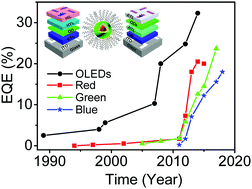当前位置:
X-MOL 学术
›
J. Mater. Chem. C
›
论文详情
Our official English website, www.x-mol.net, welcomes your
feedback! (Note: you will need to create a separate account there.)
Nanostructure and device architecture engineering for high-performance quantum-dot light-emitting diodes
Journal of Materials Chemistry C ( IF 5.7 ) Pub Date : 2018-10-02 00:00:00 , DOI: 10.1039/c8tc04028a Fei Chen 1, 2, 3 , Zhongyuan Guan 1, 2, 3 , Aiwei Tang 1, 2, 3
Journal of Materials Chemistry C ( IF 5.7 ) Pub Date : 2018-10-02 00:00:00 , DOI: 10.1039/c8tc04028a Fei Chen 1, 2, 3 , Zhongyuan Guan 1, 2, 3 , Aiwei Tang 1, 2, 3
Affiliation

|
Quantum-dot-based light-emitting diodes (QD-LEDs) have attracted considerable attention owing to their high color purity, size-dependent emission wavelength tunability, and solution processing ability as well as their inherent photo- and thermal-stability, making them suitable candidates for next-generation flat-panel displays and solid-state lighting. In the last few decades, tremendous progress has been achieved in increasing the lifetime and efficiency of QD-LEDs, with the maximum external quantum efficiency (ηEQE) of the red- and green-emitting QD-LEDs reaching 20.5% and 23.68%, respectively. These efficiencies are comparable to state-of-the-art phosphorescent organic light-emitting diodes (OLEDs) and the operational lifetimes of red- and green-emitting QD-LEDs have satisfied the requirements for use in commercial displays. In comparison with the red- and green-emitting QD-LEDs, blue-emitting QD-LEDs exhibit a lower lifetime and device efficiency. Even though the maximum ηEQE can reach 18%, the lifetime is only about 1000 h, which falls short of the basic requirements for commercial displays (>10 000 h). In this review, we present the improvements made in the device performance of QD-LEDs through optimization of the quantum dot (QD) emitting layer and device architectures. The optimization of the QD emitting layer, the effects of the nanostructure-tailoring and surface-engineering of the quantum dots on the device performance are highlighted. Moreover, owing to the toxicity of Cd-based QD-LEDs, advances in the performance of heavy-metal-free QD-LEDs are also emphasized. Furthermore, the optimization of device architectures, the progress of the device performance and the working mechanism are outlined, based on the four types of QD-LEDs. Finally, we present the challenges and future perspectives facing researchers who are developing QD-LEDs.
中文翻译:

高性能量子点发光二极管的纳米结构和器件架构工程
基于量子点的发光二极管(QD-LED)由于其高色纯度,与尺寸有关的发射波长可调性,溶液处理能力以及其固有的光稳定性和热稳定性而备受关注。下一代平板显示器和固态照明的合适候选人。在过去的几十年中,巨大的进步一直在增加的QD-LED的寿命和效率的实现,最大外量子效率(η EQE)的红色和绿色QD-LED分别达到20.5%和23.68%。这些效率可与最新的磷光有机发光二极管(OLED)相媲美,并且发红光和发绿光的QD-LED的使用寿命已经满足了商用显示器的使用要求。与发红光和发绿光的QD-LED相比,发蓝光的QD-LED具有较低的寿命和器件效率。即使最大η EQE可以达到18%,使用寿命只有1000小时左右,低于商业显示器的基本要求(> 10000小时)。在这篇综述中,我们介绍了通过优化量子点(QD)发射层和器件架构对QD-LED器件性能的改进。重点介绍了QD发射层的优化,量子点的纳米结构定制和表面工程化对器件性能的影响。此外,由于基于Cd的QD-LED的毒性,因此也强调了无重金属的QD-LED的性能的进步。此外,基于四种类型的QD-LED,概述了设备架构的优化,设备性能的进步和工作机制。最后,
更新日期:2018-10-02
中文翻译:

高性能量子点发光二极管的纳米结构和器件架构工程
基于量子点的发光二极管(QD-LED)由于其高色纯度,与尺寸有关的发射波长可调性,溶液处理能力以及其固有的光稳定性和热稳定性而备受关注。下一代平板显示器和固态照明的合适候选人。在过去的几十年中,巨大的进步一直在增加的QD-LED的寿命和效率的实现,最大外量子效率(η EQE)的红色和绿色QD-LED分别达到20.5%和23.68%。这些效率可与最新的磷光有机发光二极管(OLED)相媲美,并且发红光和发绿光的QD-LED的使用寿命已经满足了商用显示器的使用要求。与发红光和发绿光的QD-LED相比,发蓝光的QD-LED具有较低的寿命和器件效率。即使最大η EQE可以达到18%,使用寿命只有1000小时左右,低于商业显示器的基本要求(> 10000小时)。在这篇综述中,我们介绍了通过优化量子点(QD)发射层和器件架构对QD-LED器件性能的改进。重点介绍了QD发射层的优化,量子点的纳米结构定制和表面工程化对器件性能的影响。此外,由于基于Cd的QD-LED的毒性,因此也强调了无重金属的QD-LED的性能的进步。此外,基于四种类型的QD-LED,概述了设备架构的优化,设备性能的进步和工作机制。最后,











































 京公网安备 11010802027423号
京公网安备 11010802027423号